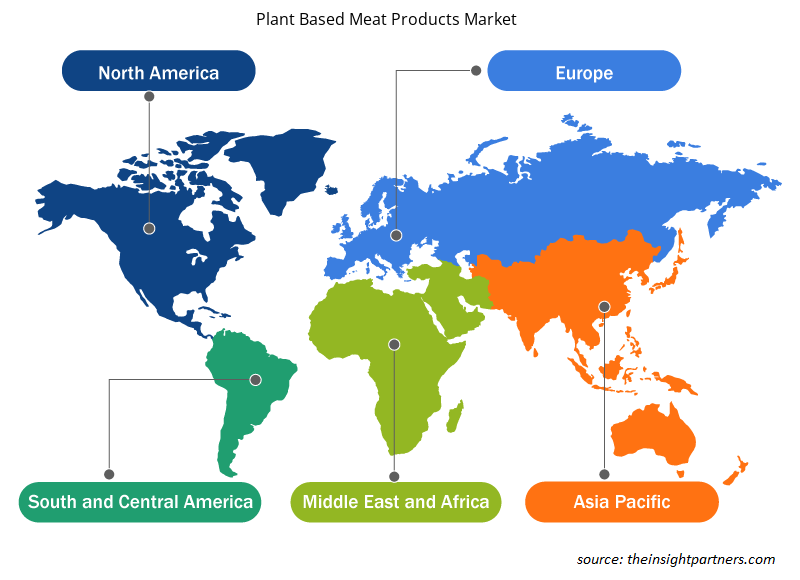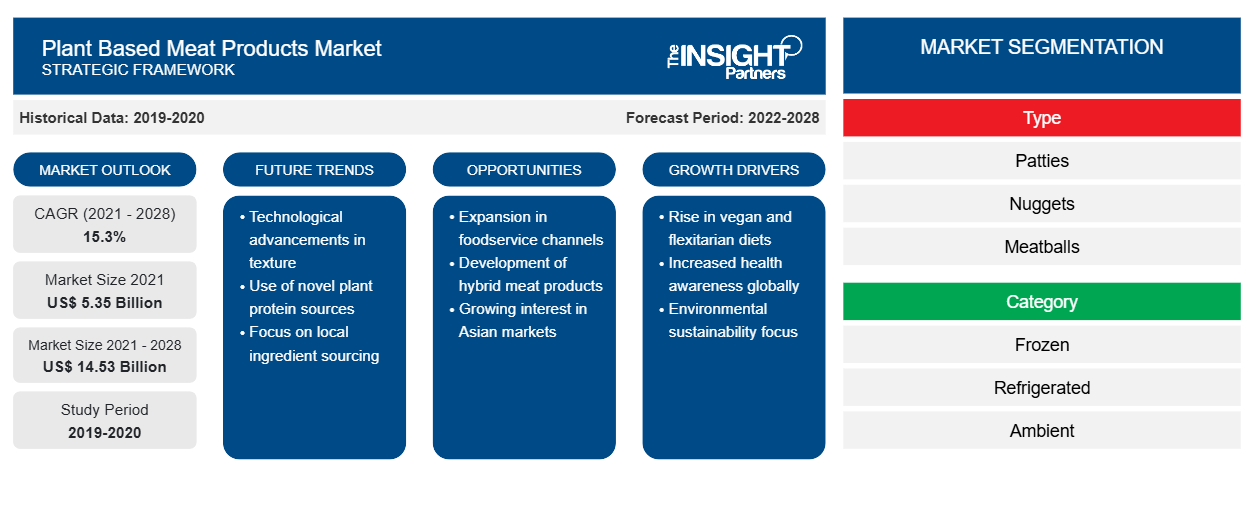[تقرير بحثي] من المتوقع أن يصل سوق منتجات اللحوم النباتية إلى 14،527.55 مليون دولار أمريكي بحلول عام 2028 من 5،354.72 مليون دولار أمريكي في عام 2021؛ ومن المتوقع أن ينمو بمعدل نمو سنوي مركب قدره 15.3٪ من عام 2021 إلى عام 2028.
رؤى السوق ووجهة نظر المحلل:
تُصنع منتجات اللحوم النباتية باستخدام البروتينات النباتية مثل بروتين الصويا وبروتين البازلاء وبروتين القمح. يُستخدم بروتين الصويا على نطاق واسع في صنع منتجات اللحوم النباتية لأنه ميسور التكلفة مقارنة بالبروتينات النباتية الأخرى ويوفر نسيجًا مثاليًا للمنتجات التي تشبه منتجات اللحوم الحيوانية التقليدية. تعد الفطائر والنقانق والكرات اللحمية من بين منتجات اللحوم النباتية الشائعة المتوفرة في السوق. يميل المستهلكون بشدة نحو المنتجات النباتية أو الصديقة للنباتيين بسبب المخاوف الصحية المتزايدة والوعي المتزايد بشأن رعاية الحيوان. إن الوعي الصحي المتزايد بين الناس بسبب انتشار السمنة والسكري والأمراض الأخرى يجبر الناس على تغيير عاداتهم الغذائية. يرى الناس عمومًا أن المنتجات النباتية أكثر صحة من المنتجات الحيوانية التقليدية. هذا العامل يدفع بشكل كبير نمو سوق منتجات اللحوم النباتية
محركات النمو والتحديات:
تحتوي منتجات اللحوم النباتية على نسبة أقل من الدهون المشبعة والسعرات الحرارية مقارنة بمنتجات اللحوم التقليدية، مما يجعلها خيارًا أكثر صحة. هذا العامل هو المحرك لنمو سوق منتجات اللحوم النباتية. كما يُعزى صعود اتجاه النباتية إلى زيادة التعاطف مع الحيوانات. وقد أثار الوعي المتزايد بشأن سوء معاملة الحيوانات في المسالخ والمصانع مخاوف بشأن حماية الحيوان بين المستهلكين. ومن المتوقع أيضًا أن يعزز هذا العامل استهلاك الأطعمة النباتية، مما يحرك سوق منتجات اللحوم النباتية. ومع ذلك، فإن سعرها المرتفع يحد من استخدامها بين المستهلكين الحساسين للسعر. في سلاسل السوبر ماركت الرائدة، مثل كروجر وول مارت، يمكن شراء قطعتين من فطائر الهامبرغر النباتية من بيوند ميت بحوالي 5.99 دولارًا أمريكيًا. من ناحية أخرى، يتوفر رطلان من لحم البقر المفروم بنفس السعر تقريبًا، مما قد ينتج عنه 10 أضعاف عدد فطائر الهامبرغر. وبالتالي، بعد مقارنة الأسعار، ينتهي الأمر بالمستهلكين عمومًا إلى شراء اللحوم التقليدية بدلاً من اللحوم النباتية، وهو ما يشكل عائقًا في نمو سوق منتجات اللحوم النباتية . يركز المصنعون على تحقيق اقتصاديات الحجم لتقليل التكلفة الإجمالية المطلوبة لتصنيع منتجات اللحوم النباتية. وقد تساعد هذه المبادرة المصنعين على اكتساب عملاء جدد حتى في الأسواق الحساسة للسعر.
قم بتخصيص هذا التقرير ليناسب متطلباتك
ستحصل على تخصيص لأي تقرير - مجانًا - بما في ذلك أجزاء من هذا التقرير، أو تحليل على مستوى الدولة، وحزمة بيانات Excel، بالإضافة إلى الاستفادة من العروض والخصومات الرائعة للشركات الناشئة والجامعات
- احصل على أهم اتجاهات السوق الرئيسية لهذا التقرير.ستتضمن هذه العينة المجانية تحليلاً للبيانات، بدءًا من اتجاهات السوق وحتى التقديرات والتوقعات.
تقسيم التقرير ونطاقه:
"سوق منتجات اللحوم النباتية العالمية مقسمة على أساس النوع والفئة وقناة التوزيع والجغرافيا. بناءً على النوع، يتم تقسيم سوق منتجات اللحوم النباتية إلى فطائر، وقطع صغيرة، وكرات لحم، وسجق، وغيرها. بناءً على الفئة، يتم تقسيم سوق منتجات اللحوم النباتية إلى مجمدة ومبردة ومحيطة. بناءً على قناة التوزيع، يتم تقسيم سوق منتجات اللحوم النباتية إلى محلات السوبر ماركت والهايبر ماركت، ومتاجر التجزئة، والتجزئة عبر الإنترنت، وغيرها. يتم تقسيم سوق منتجات اللحوم النباتية على أساس الجغرافيا إلى أمريكا الشمالية (الولايات المتحدة وكندا والمكسيك)، وأوروبا (ألمانيا وفرنسا وإيطاليا والمملكة المتحدة وروسيا وبقية أوروبا)، وآسيا والمحيط الهادئ (أستراليا والصين واليابان والهند وكوريا الجنوبية وبقية آسيا والمحيط الهادئ)، والشرق الأوسط وأفريقيا (جنوب أفريقيا والمملكة العربية السعودية والإمارات العربية المتحدة وبقية الشرق الأوسط وأفريقيا)، وأمريكا الجنوبية والوسطى (البرازيل والأرجنتين وبقية أمريكا الجنوبية والوسطى)"
التحليل القطاعي:
بناءً على النوع، يتم تقسيم سوق منتجات اللحوم النباتية إلى فطائر، وقطع صغيرة من اللحم، وكرات لحم، وسجق، وغيرها. في عام 2021، احتلت شريحة الفطائر الحصة الأكبر في سوق منتجات اللحوم النباتية.
بناءً على قناة التوزيع، يتم تقسيم سوق منتجات اللحوم النباتية إلى محلات السوبر ماركت والهايبر ماركت ومتاجر السلع الغذائية وتجارة التجزئة عبر الإنترنت وغيرها. احتل قطاع محلات السوبر ماركت والهايبر ماركت أكبر حصة في السوق في عام 2021 ومن المتوقع أن يسجل قطاع التجزئة عبر الإنترنت أعلى معدل نمو سنوي مركب خلال فترة التوقعات. تعد تجارة التجزئة عبر الإنترنت واحدة من أسرع قنوات التوزيع نموًا نظرًا لراحتها من حيث التسوق وتسليم المنتجات. تقدم متاجر التجزئة عبر الإنترنت مجموعة واسعة من المنتجات بخصومات كبيرة؛ كما يمكن للمستهلكين شراء المنتجات المرغوبة بسهولة عن بُعد. تجذب خدمة التوصيل إلى المنازل مجموعة كبيرة من العملاء للتسوق من خلال منصة التجارة الإلكترونية. تقدم مواقع التجارة الإلكترونية معلومات مفصلة عن المنتج، إلى جانب مراجعات المستخدمين، مما يساعد المشترين على مقارنة المنتجات واتخاذ قرارات مستنيرة. تعمل هذه العوامل بشكل كبير على دفع نمو القطاع على مدار السنوات القادمة.
التحليل الإقليمي:
بناءً على الجغرافيا، ينقسم سوق منتجات اللحوم النباتية إلى خمس مناطق رئيسية: أمريكا الشمالية وأوروبا وآسيا والمحيط الهادئ وأمريكا الجنوبية والوسطى والشرق الأوسط وأفريقيا. بلغ حجم سوق منتجات اللحوم النباتية العالمية لأوروبا 2060.30 مليون دولار أمريكي في عام 2021. تعد أمريكا الشمالية ثاني أكبر مساهم بحصة تزيد عن 30٪ في السوق العالمية. تعد منطقة آسيا والمحيط الهادئ أيضًا واحدة من الأسواق الرئيسية لمنتجات اللحوم النباتية التي تنمو بمعدل نمو سنوي مركب يبلغ حوالي 15٪. يميل المستهلكون بشدة نحو المنتجات النباتية بسبب الوعي المتزايد بشأن رعاية الحيوان. تعزز فوائد الأطعمة البروتينية الخالية من الكوليسترول، ذات الملمس الشبيه باللحوم، نمو سوق منتجات اللحوم النباتية في أوروبا. علاوة على ذلك، مع ميل المستهلكين المتزايد نحو منتجات اللحوم النباتية، يتبنى المصنعون استراتيجيات النمو مثل تطوير المنتجات والتوسع لتلبية الطلبات المتزايدة للمستهلكين. على سبيل المثال، افتتحت Plant & Bean مصنعًا للحوم النباتية في بوسطن ولينكولنشاير (المملكة المتحدة) في ديسمبر 2020 لخدمة السوق الأوروبية. يتمتع هذا المصنع بطاقة إنتاجية أصلية تبلغ 55 ألف طن من اللحوم النباتية سنويًا.
تطورات الصناعة والفرص المستقبلية:
فيما يلي قائمة بالمبادرات المختلفة التي اتخذها اللاعبون الرئيسيون العاملون في سوق منتجات اللحوم النباتية:
- في ديسمبر 2022، أطلقت شركة United Supermarket Holdings, Inc. منتج "BEYOND BEEF"، وهو بديل نباتي للحوم تم إنشاؤه بواسطة Beyond Meat, Inc. BEYOND BEEF هو بديل نباتي يشبه لحم البقر المفروم للحوم البقر المفرومة التقليدية والذي يمكن استخدامه كمكون في مجموعة متنوعة من الأطباق مثل فطائر البرجر وكرات اللحم وغيرها.
- في أكتوبر 2022، أطلقت شركة Licious، وهي شركة مقرها الهند، العلامة التجارية للحوم النباتية "UnCrave" والتي تتكون من سيخ كباب الدجاج ولحم الضأن النباتي ضمن محفظتها.
- في مارس 2022، شكلت Beyond Meat وPepsiCo مشروعًا مشتركًا تحت اسم "Planet Partnerships LLC" مع إطلاق لحم Beyond Meat المجفف المصنوع من مكونات نباتية 100% مثل البازلاء والفاصوليا الخضراء.
رؤى إقليمية حول سوق منتجات اللحوم النباتية
لقد قام المحللون في Insight Partners بشرح الاتجاهات والعوامل الإقليمية المؤثرة على سوق منتجات اللحوم النباتية طوال فترة التوقعات بشكل شامل. يناقش هذا القسم أيضًا قطاعات سوق منتجات اللحوم النباتية والجغرافيا في جميع أنحاء أمريكا الشمالية وأوروبا ومنطقة آسيا والمحيط الهادئ والشرق الأوسط وأفريقيا وأمريكا الجنوبية والوسطى.

- احصل على البيانات الإقليمية المحددة لسوق منتجات اللحوم النباتية
نطاق تقرير سوق منتجات اللحوم النباتية
| سمة التقرير | تفاصيل |
|---|---|
| حجم السوق في عام 2021 | 5.35 مليار دولار أمريكي |
| حجم السوق بحلول عام 2028 | 14.53 مليار دولار أمريكي |
| معدل النمو السنوي المركب العالمي (2021 - 2028) | 15.3% |
| البيانات التاريخية | 2019-2020 |
| فترة التنبؤ | 2022-2028 |
| القطاعات المغطاة | حسب النوع
|
| المناطق والدول المغطاة | أمريكا الشمالية
|
| قادة السوق وملفات تعريف الشركات الرئيسية |
|
كثافة اللاعبين في سوق منتجات اللحوم النباتية: فهم تأثيرها على ديناميكيات الأعمال
يشهد سوق منتجات اللحوم النباتية نموًا سريعًا، مدفوعًا بالطلب المتزايد من المستخدم النهائي بسبب عوامل مثل تفضيلات المستهلكين المتطورة والتقدم التكنولوجي والوعي المتزايد بفوائد المنتج. ومع ارتفاع الطلب، تعمل الشركات على توسيع عروضها والابتكار لتلبية احتياجات المستهلكين والاستفادة من الاتجاهات الناشئة، مما يؤدي إلى زيادة نمو السوق.
تشير كثافة اللاعبين في السوق إلى توزيع الشركات أو المؤسسات العاملة في سوق أو صناعة معينة. وهي تشير إلى عدد المنافسين (اللاعبين في السوق) الموجودين في مساحة سوق معينة نسبة إلى حجمها أو قيمتها السوقية الإجمالية.
الشركات الرئيسية العاملة في سوق منتجات اللحوم النباتية هي:
- ما وراء اللحوم
- كوناجرا براندز، المحدودة
- كيلوج
إخلاء المسؤولية : الشركات المذكورة أعلاه ليست مرتبة بأي ترتيب معين.

- احصل على نظرة عامة على أهم اللاعبين الرئيسيين في سوق منتجات اللحوم النباتية
تأثير كوفيد-19:
أثرت جائحة كوفيد-19 على جميع الصناعات تقريبًا في مختلف البلدان. أعاقت عمليات الإغلاق والقيود على السفر وإغلاق الشركات في أمريكا الشمالية وأوروبا ومنطقة آسيا والمحيط الهادئ وأمريكا الجنوبية والوسطى والشرق الأوسط وأفريقيا نمو العديد من الصناعات، بما في ذلك صناعة الأغذية والمشروبات. خلال المرحلة الأولية من جائحة كوفيد-19، تسببت الاضطرابات الشديدة في سلسلة التوريد في نقص المواد الخام، مما أدى إلى زيادة أسعار المواد الخام. وفقًا لوزارة الزراعة الأمريكية، ارتفعت أسعار بروتين البازلاء وهو أحد المكونات الشائعة المستخدمة في اللحوم النباتية بسبب الاضطرابات في سلسلة التوريد. أدى هذا إلى ارتفاع الأسعار، مما أثر سلبًا على الطلب على منتجات اللحوم النباتية. ومع ذلك، بسبب التحول الكبير في تفضيلات المستهلكين الغذائية، زاد الطلب على منتجات اللحوم النباتية بشكل كبير بعد تفشي كوفيد-19. نشرت منظمة الصحة العالمية إرشادات حول المنتجات الغذائية التي يجب استهلاكها أثناء جائحة كوفيد-19. اقترحت الإرشادات الحد من استهلاك اللحوم الحمراء بسبب ارتفاع نسبة الدهون المشبعة فيها. علاوة على ذلك، تحول الأشخاص الذين ركزوا على تقليل استهلاكهم الكلي للحوم إلى اتباع أنظمة غذائية نباتية وخالية من المنتجات الحيوانية لتحسين المناعة. وكان لهذه العوامل تأثير إيجابي على نمو سوق منتجات اللحوم النباتية.
المنافسة والشركات الرئيسية:
تشمل بعض اللاعبين البارزين العاملين في سوق منتجات اللحوم النباتية العالمية ما يلي:بيوند ميت؛ كوناجرا براندز، إنك؛ إمبوسيبل فودز إنك؛ كوورن فودز، إنك؛ كيلوج كومباني؛ هيلاري إيت ويل؛ فيبيتس فودز، ليمتد؛ بيفور ذا بوتشر؛ فيلد روست؛ وتوفوركي؛ وغيرها. وتشارك هذه الشركات بشكل كبير في ابتكار المنتجات وتطوير المنتجات الجديدة لتعزيز خبراتها وتوسيع محفظة منتجاتها. وعلاوة على ذلك، تتعاون هذه الشركات أيضًا مع لاعبين آخرين في الصناعة لتلبية احتياجات قاعدة عملاء أوسع. ومن المتوقع أن توفر مثل هذه المبادرات إمكانات نمو قوية للاعبين الرئيسيين في الصناعة الذين يعملون في سوق منتجات اللحوم النباتية.
- التحليل التاريخي (سنتان)، سنة الأساس، التوقعات (7 سنوات) مع معدل النمو السنوي المركب
- تحليل PEST و SWOT
- حجم السوق والقيمة / الحجم - عالمي، إقليمي، بلد
- الصناعة والمنافسة
- مجموعة بيانات إكسل
التقارير الحديثة
تقارير ذات صلة
شهادات العملاء
سبب الشراء
- اتخاذ قرارات مدروسة
- فهم ديناميكيات السوق
- تحليل المنافسة
- رؤى العملاء
- توقعات السوق
- تخفيف المخاطر
- التخطيط الاستراتيجي
- مبررات الاستثمار
- تحديد الأسواق الناشئة
- تحسين استراتيجيات التسويق
- تعزيز الكفاءة التشغيلية
- مواكبة التوجهات التنظيمية





















 احصل على عينة مجانية ل - سوق منتجات اللحوم النباتية
احصل على عينة مجانية ل - سوق منتجات اللحوم النباتية